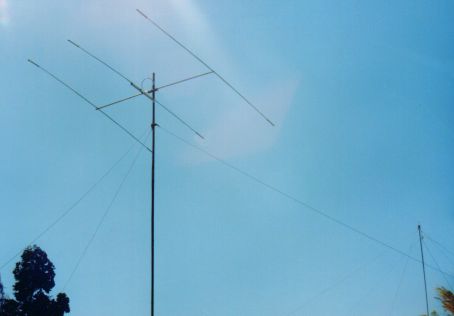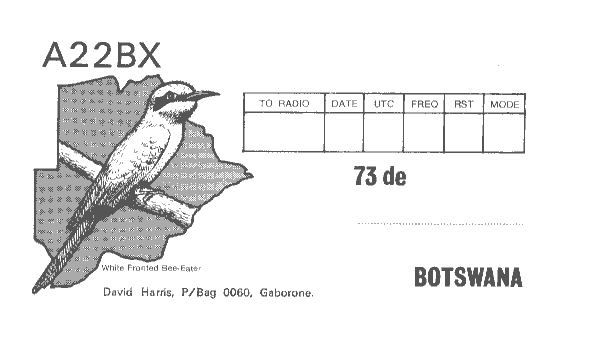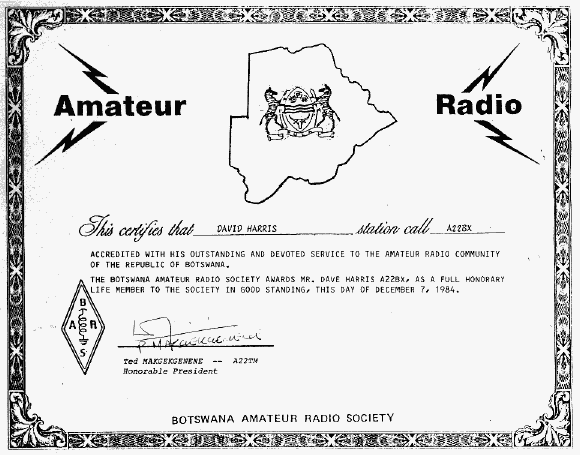

The shortwave transmitting aerial which towered above our house for several years.
I mentioned that I had a keen interest in ham radio. Although the arrival of digital communications, mobile phones and the Internet has diminished the appeal of this hobby nowadays, at the time ham radio was a wonderful way of keeping in touch with the rest of the world from the middle of Africa. It helped that there were only about 5 other active hams in the country, so whenever I went on the air dozens of people in other countries recognised the rarity of the callsign and wanted to make contact.

These cards were in great demand by amateurs in other countries
I'd learned a lot with my ham licence, which I'd acquired in 1967 as I left school. There's a very practical side of the hobby which complemented the time spent on professional duties. I certainly picked up a lot of radio theory as well and spent happy hours (often at awful times in the morning and to the despair of Pru) chatting to every continent and even communicating with satellites - leading edge stuff at that time. Botswana is directly opposite Hawaii and it was always easy to talk to amateurs there. It was even more fun some mornings to send a very short "pip" on the morse key and listen to it coming back a seventh of a second later - having travelled completely round the world and still being audible in the low-interference rural environment. (Wasn't I sad?)

At the side of the Drake TR7 radio transceiver is the Sinclair MK14 computer I built in a cardboard "box" file. Featuring an SC/MP processor, tape input/output and a massive 640 bytes of RAM (well, I had bought the optional extra memory!), it's still working. In Botswana in 1978 it was something of an achievement to get it going at all without any outside help. I wrote my first program in machine code over a weekend to decode morse code onto a 7-segment LED display. If I'd known then what I know now I'd never have even attempted such a complex task - especially as my first project!
Although I knew first-hand the benefits of the hobby for self-training, not many others around me did. Ham radio was seen by many African countries as at best an eccentric (and presumably expensive) expatriate pastime; at worst a dangerous security risk. In 1979 a World Administrative Radio Conference was scheduled. It was the first such conference for 20 years and the more developed countries, notably the USA which had the largest number of radio hams in the world, were worried that they would be outvoted on the "waste" of radio spectrum allocated to the amateur service.
The American Radio Relay League (ARRL), to their credit, did something practical to protect their position. They sent a special envoy, Bruce Johnson, to several African countries to stress the educational advantages of a strong amateur radio movement. To back it up they had designed a low-cost transmitter/receiver kit for distribution to individuals who were interested but unable to afford commercial equipment. It was all in the best traditions of amateur radio and I tried not to be too cynical about their real motives.
When Bruce arrived in my office I was at pains to point out that the hobby currently had little real relevance to Batswana. The Botswana Amateur Radio Society had been founded in 1976 but had only about 12 members (virtually all expatriate) and no real activities. However, Ted and I could see that there might be some real benefit to be gained if the ARRL could help with training materials. Ted was one of the official delegates to WARC-79 in Geneva and so he was a good convert for Bruce! We duly received a shipment of some truly excellent electronics and radio lecture notes and self-study guides. These were followed by a dozen of the low-cost transceivers (although I had to pay a hefty customs import bill for them!) and we started to introduce the concept of amateur radio to the small number of students doing electronics. Our project was written up in the September 1979 issue of "QST", the official magazine of the American Radio Relay League; there's a copy here (filesize=91k).
Over the next two or three years we worked hard to build in the grounds of the Botswana Polytechnic a hut which was to become a "club station." The Polytechnic gave us the space and persuaded the students on the building course to lay the concrete foundation slab as part of their practical studies. Meanwhile I liaised with the Botswana Telecommunications Corporation to ensure that the Botswana amateur licence was close in content to its UK equivalent. This meant that we could use the UK City and Guilds Radio Amateurs' Examination (RAE) as a qualification, and anyone who took this would have a C&G certificate to impress future employers. It also meant international acceptance for the Botswana licence.
The local Rotary Club, of which I just happened to be a member, arranged for the donation of some serious equipment to make the set-up really useful.

Radio equipment presented by Gaborone Rotary Club
By 1984 we were able to ask the Minister of Communications to officially declare a small prefabricated building, which had had a previous existence as a garden shed, to be the official headquarters of the Botswana Amateur Radio Society, with the call-sign A22RS. It was one of the proudest moments of my life.

This certificate was presented to me when I left Botswana. BARS had never had a life member before!